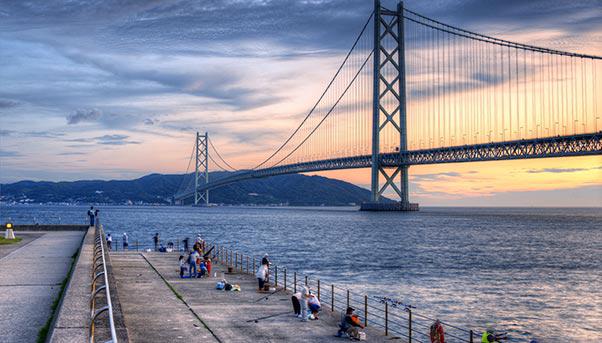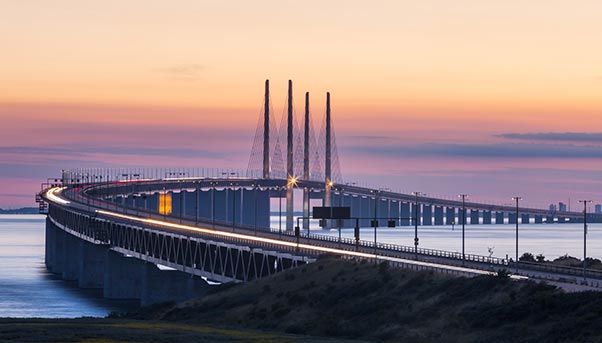
The bridge is a great accelerator for the economy and development in general. By uniting distant shores, it brings people together, intensifies trade, and shortens distances between towns and cities that would otherwise be far from each other.
The impact that this piece of infrastructure can have on an economy is profound. The Federal Reserve of San Francisco calculates that every dollar spent building a bridge and the corresponding roadwork leads to two dollars of economic growth in the interested area. But it is the specific stories of bridges that best illustrate this impact and the way they contribute to development.
Øresund Bridge in Denmark
One of the world champions of bridges is Denmark. The country is virtually surrounded by water and, even though it has only five million inhabitants, it is equipped with a set of modern bridges that allow it to overcome its isolation. The best example is the Øresund Bridge, which links Denmark with Sweden. Inaugurated on July 1, 2000, it cost €2.6 billion to erect. It is nearly eight kilometres long and part of it becomes a tunnel under the sea bed before arriving on the Swedish side. Its impact has been enormous. Since its opening, traffic between the two countries has increased by 60%, with 3.5 million people using the bridge every year. Sweden’s statistics institute has calculated that, since its inauguration, the bridge has contributed to the creation of €11 billion of wealth between the two countries, an amount generated from toll payments to an increase in commerce.
The Fatih Sultan Mehmet Bridge in Turkey
Something similar occurred in Istanbul, the capital of Turkey and the only city in the world that finds itself astride two continents: Europe and Asia. The first bridge to cross the Bosphorus River that divides the continents was put up in 1973 in response to the demands of the city’s growing population. A second bridge – the Fatih Sultan Mehmet - went up between 1985 and 1994, with the participation of a Salini Impregilo predecessor. It became an integral part of the Kinali-Sakarya highway, which runs for 247 kilometres between the cities of Kinali in Europe and Kazanci in Asia. The bridge itself is 1.09 kilometres long. At the time of its construction, it was one of the longest suspension bridges in the world. Commerce between the two sides of the river has risen in the seven years since its opening by 31.8%.
Two special bridges Canada: the Ambassador Bridge and the Gordie Howe International Bridge
This kind of impact can also be witnessed between countries, such as the United States and Canada.

The Ambassador Bridge, for example, has linked Detroit with Windsor since 1929. Despite its age, it is still an important transit point, with $400 billion worth of goods crossing it every year.
Then there is the Gordie Howe International Bridge that is under construction, which will also link Detroit with Windsor. When it will open in 2020, it is expected to help increase commercial traffic in the area by 128%.
The Ohio River Bridges Project in the U.S.
But one of the most important undertakings is happening in the United States with the Louisville-Southern Indiana Ohio River Bridges Project, which is overseeing the construction of a series of bridges and highway links over the eponymous river at a cost of about $2.3 billion. According to a study commissioned in 2014 by the Indiana Finance Authority, the completed project will stimulate the creation of nearly 15,000 jobs a year and an increase in the wealth produced in the Louisville region by $86.7 billion in the 30 years following its opening.
From the Brooklyn Bridge - which contributed to a boom in the population of the neighbourhood from 580,000 to one million in the 15 years following its inauguration – to the most modern bridges of the present day, the advancements in engineering and construction materials means public works are becoming safer.
The Akashi- Kaikyō in Japan
In Japan, one of the country’s most exposed to seismic risk in the world, the Akashi-Kaikyo Bridge, is an example of how these advancements have contributed to the construction of an enormous structure that can resist the forces of natures. The bridge has a single span of nearly two kilometres, making it one of the longest for a suspension bridge in the world. But notwithstanding this characteristic, it suffered no heavy damages when in 1995 an earthquake registering 6.8 on the Richter scale struck while it was still under construction.
Since its opening in 1998, the bridge, which links Kobe on Honshu Island with Awaji Island, has never closed despite the passage of typhoons with winds of up to 200 kilometres per hour. According to Japanese calculations, the first year of its opening registered an increase in commercial activity in the area by $500 million, up by 90%. Travel time was also drastically reduced. From Kobe to Tokushima it went from 270 to 100 minutes, from Kurashiki to Sakaide from 120 to 40 minutes, and from Onomichi to Imabari from 160 to 80 minutes.
Shorter travel times, more commerce… these are the benefits that come not only from the Akashi-Kaikyo but from many other bridges in the world. From America to Asia, passing through Europe, this is the impact that big bridges make on the territory they serve, confirming their title as strategic infrastructure.


